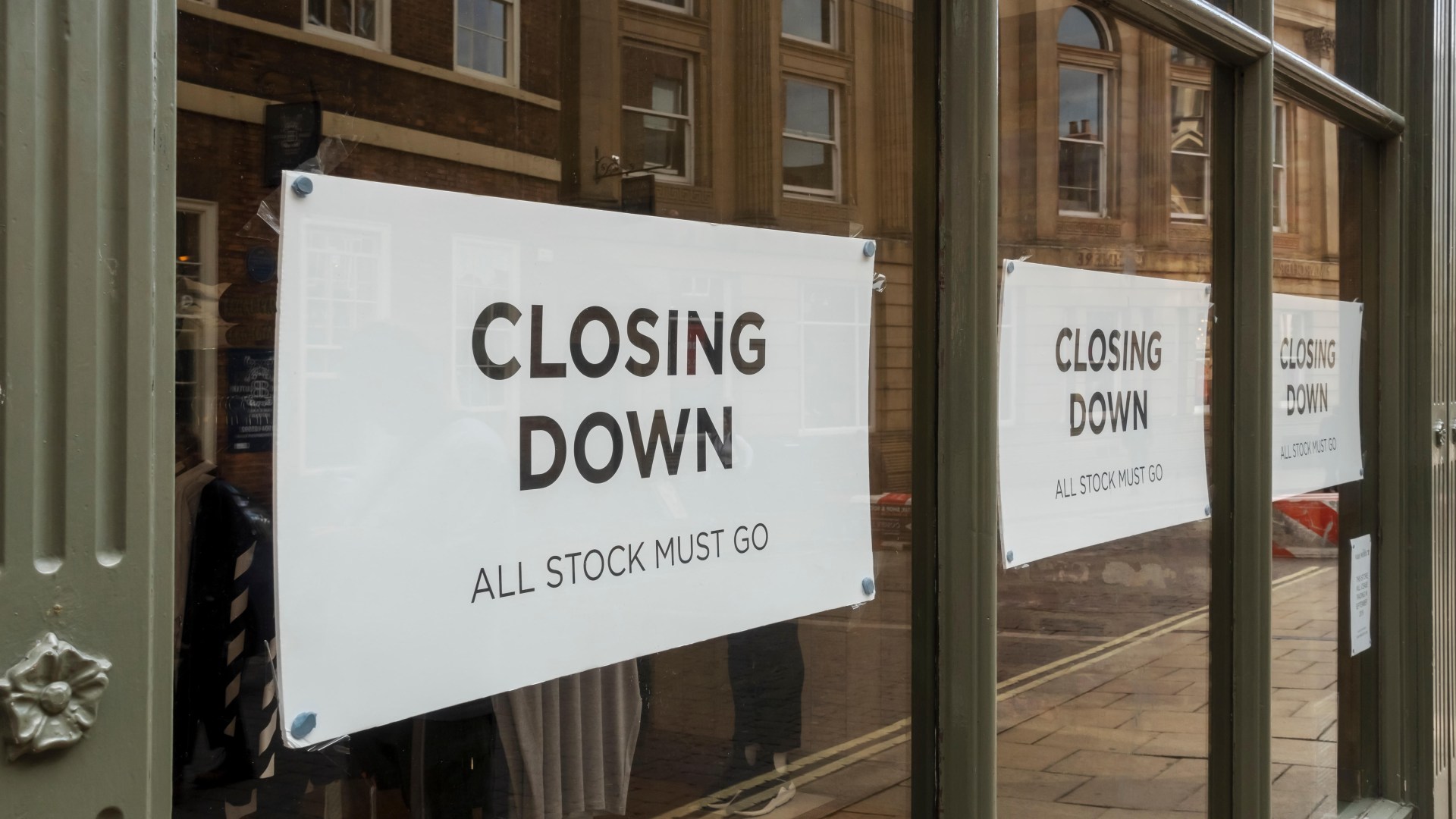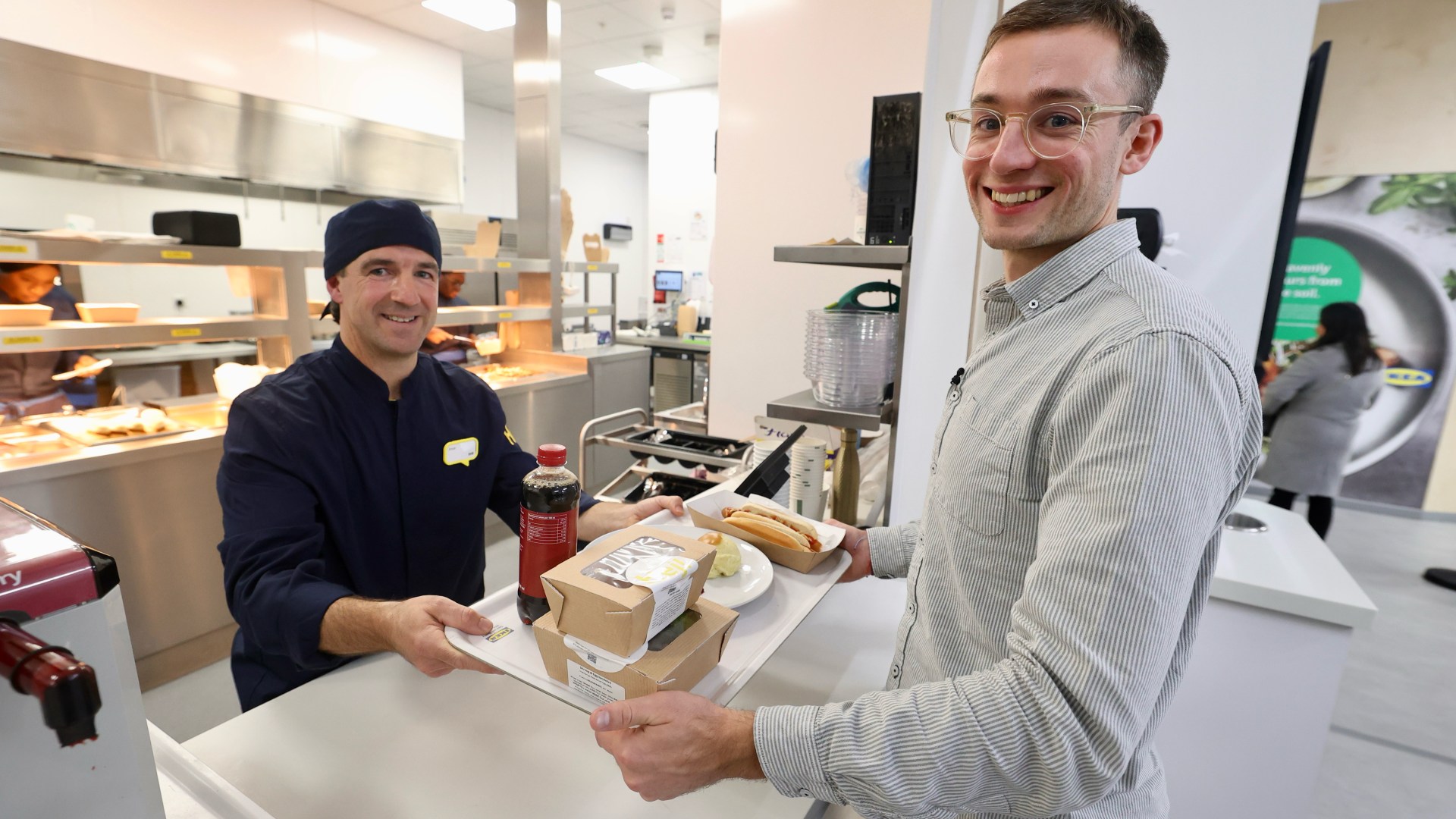Money
Outdoor clothing chain with 67 branches launches huge clearance sale ahead of closing six high street stores

A POPULAR outdoor clothing chain is set to close six stores and has launched a huge closing down sale at each branch.
Millets has launched clearance sales at six of its stores in recent weeks, and shoppers can get 30% off all stock.
All of the affected are expected to close early in the New Year.
However, four of these locations will be reopened and rebranded as GO Outdoors, a sister brand to Millets.
These include sites in Lowestoft, Douglas, York and Grimsby.
Millets in Burgess Hill, West Sussex will not be rebranded and is set to close permanently in January.
Millets stocks big-name brands, including the likes of Berghaus, The North Face and Jack Wolfskin.
As of November 11, the retailer operates 67 branches across the UK.
The rebranding of the three stores to Go Outdoors sites indicates that JD Outdoors, the owner of Millets, is prioritising the expansion of its sister brand.
Founded in Sheffield in 1998, the company has swiftly risen to become one of the most recognised names in the outdoor retail market.
There are now 96 Go Outdoors sites across the county.
Like Millets, GO Outdoors offers everything needed for camping trips and other outdoor activities, stocking the same big brands.
HISTORY OF MILLETS

MILLETS, a staple in the outdoor clothing and equipment market, has a rich history dating back to its founding in 1893.
Originally established in Southampton, the store began as a drapery business before evolving to specialise in camping and outdoor gear.
Over the decades, Millets expanded its product range to include various outdoor clothing, footwear, and equipment, catering to adventurers and outdoor enthusiasts.
In the mid-20th century, the brand gained popularity for its quality products and reliable customer service, leading to the opening of numerous stores across the UK.
Millets became synonymous with outdoor exploration, from camping and hiking to mountaineering and beyond.
In 1986, it formed Millets Leisure plc.
This became the Outdoor Group in 1996 with 158 stores, which was bought by Blacks Leisure plc in 1999.
In recent years, Millets has continued to adapt to the changing retail landscape, embracing online shopping while maintaining a strong high street presence.
Despite facing challenges in the competitive market, the brand remains a go-to destination for outdoor gear and is known for its commitment to quality and customer satisfaction.
Today, Millets is part of the JD Sports Fashion plc group.
However, unlike Millets, GO Outdoors offers a Membership Card, which grants access to unbeatable prices across various departments. The card can be purchased online or in-store for just £5 a year.
It can be purchased online or in-store for just £5 a year.
With the membership card, customers can access exclusive discounts and a price match guarantee, ensuring they always receive the best deal.
Lee Bagnall, CEO of JD Outdoors, said: “We always aim to provide the best possible experience for our customers, so by converting these stores to a GO Express, customers will be able to benefit from the GO Outdoors loyalty programme, which offers exclusive and more affordable prices for members.”
HIGH STREET WOES
Retailers have been feeling the squeeze since the pandemic, while shoppers are cutting back on spending due to the soaring cost of living crisis.
High energy costs and a move to shopping online after the pandemic are also taking a toll, and many high street shops have struggled to keep going.
The high street has seen a whole raft of closures over the past two years, and more are coming.
Although there were some big-name losses from the high street, including Wilko, many large companies had already gone bust before 2022, the centre said, such as Topshop owner Arcadia, Jessops and Debenhams.
Alongside Wilko, which employed around 12,000 people when it collapsed, 2023’s biggest failures included Paperchase, Cath Kidston, Planet Organic and Tile Giant.
However, The Centre for Retail Research said that most store closures relate to companies trying to reorganise and cut costs rather than the business failing.
Why are retailers closing shops?
EMPTY shops have become an eyesore on many British high streets and are often symbolic of a town centre’s decline.
The Sun’s business editor Ashley Armstrong explains why so many retailers are shutting their doors.
In many cases, retailers are shutting stores because they are no longer the money-makers they once were because of the rise of online shopping.
Falling store sales and rising staff costs have made it even more expensive for shops to stay open. In some cases, retailers are shutting a store and reopening a new shop at the other end of a high street to reflect how a town has changed.
The problem is that when a big shop closes, footfall falls across the local high street, which puts more shops at risk of closing.
Retail parks are increasingly popular with shoppers, who want to be able to get easy, free parking at a time when local councils have hiked parking charges in towns.
Many retailers including Next and Marks & Spencer have been shutting stores on the high street and taking bigger stores in better-performing retail parks instead.
Boss Stuart Machin recently said that when it relocated a tired store in Chesterfield to a new big store in a retail park half a mile away, its sales in the area rose by 103 per cent.
In some cases, stores have been shut when a retailer goes bust, as in the case of Wilko, Debenhams Topshop, Dorothy Perkins and Paperchase to name a few.
What’s increasingly common is when a chain goes bust a rival retailer or private equity firm snaps up the intellectual property rights so they can own the brand and sell it online.
They may go on to open a handful of stores if there is customer demand, but there are rarely ever as many stores or in the same places.
Money
GPE reviewing £1bn pipeline of deals amid strong leasing performance

Great Portland Estates (GPE) has reported strong leasing, a small rise in values and a £1bn pipeline of acquisitions under review, in the firm’s results for the six months to 30 September.
The post GPE reviewing £1bn pipeline of deals amid strong leasing performance appeared first on Property Week.
Money
Burberry Launches £40M Cost-Cutting Amid Strategy Overhaul Meta Description:

Burberry Unveils £40M Cost-Cutting Drive Amid Plummeting Sales and Bold Strategy Shift
Luxury fashion house Burberry is embarking on a £40 million cost-cutting initiative and a sweeping strategy overhaul as it battles slumping sales and a battered share price. The historic brand, known for its iconic trench coats and plaid designs, faces mounting pressure after its share price tumbled more than 50% over the past year, compounded by declining sales in key markets, particularly China.
Burberry’s new CEO, Joshua Schulman, appointed in July, has promised a renewed focus on “productivity, simplification, and financial discipline” in an effort to stabilize the struggling brand. As part of this ambitious shift, Schulman announced that Burberry’s turnaround will include improvements to its digital platforms, enhanced in-store productivity, and revised pricing strategies. He emphasized a return to the brand’s heritage, aiming to refocus on signature items like outerwear and better cater to Burberry’s core customer base.
Financial Setbacks and Strategic Course Correction
The luxury retailer swung from a £223 million profit in the first half of last year to a £53 million loss in the same period this year. Revenues dropped by 20% year-on-year to £1.09 billion, leading Burberry to suspend its dividend to shareholders, a move that underscores the brand’s urgent need for financial recovery.
Schulman explained that the company’s recent underperformance was due in part to “inconsistent brand execution” and a “lack of focus on our core outerwear category and core customer segments.” He expressed a sense of urgency: “Today, we are acting with urgency to course-correct, stabilize the business, and position Burberry for a return to sustainable, profitable growth.”
China Sales Decline and Market Challenges
Burberry has been hit hard by a stagnant global luxury market, with its crucial Chinese market experiencing a significant downturn. Sales in mainland China fell 24% in the first half, and this decline worsened in the second quarter. The brand’s restructuring costs for the period, including redundancies, totaled £12 million.
These challenges come amid Burberry’s recent relegation from the FTSE 100 to the FTSE 250 after its share price hit a 14-year low earlier this year. A temporary lift in share prices occurred in recent weeks following speculation that Italian luxury brand Moncler, owner of Stone Island, was interested in a potential takeover. However, Thursday’s results report contained no mention of a buyout, and recent updates suggest a deal is unlikely.
Ambitious Foundations and Industry Reactions
Schulman’s turnaround strategy, dubbed the “Burberry Forward” initiative, has been received with cautious optimism by some investors. Richard Hunter, head of markets at Interactive Investor, commented, “The group’s recently chequered past looks set to continue for now, although the group has laid some ambitious foundations for a new ‘Burberry Forward’ strategy.”
Hunter acknowledged the severe impact on Burberry’s share price, which has plunged by 72% since April 2023, calling the recent small rebound a “small mercy” in a difficult financial landscape.
Kathleen Brooks, research director at investment firm XTB, noted that Burberry “still has a mountain to climb,” particularly with the continuing slump in China, a critical market for luxury brands.
Despite the strategy overhaul and Schulman’s pledges for reform, analysts remain cautious. Market consensus currently rates Burberry as a “sell” due to the lack of measurable progress on the company’s new direction.
Moving Forward: Burberry’s Path to Revival
Burberry’s immediate focus under Schulman is on refocusing its offerings around brand-defining products, like outerwear, while recalibrating its pricing to better fit its product categories. The company also aims to modernize its brand without losing sight of its heritage, recognizing that its emphasis on innovation has at times come “at the expense of celebrating our heritage.”
As Burberry works to recover its footing, it faces formidable challenges: a weakened presence in key markets, the effects of a depressed global luxury sector, and a shaken investor confidence. Whether the “Burberry Forward” strategy can restore the brand’s stature and profitability remains uncertain, but with Schulman at the helm, the luxury fashion giant appears ready to confront these hurdles with renewed focus and resolve.
Money
Guiding clients through the Budget changes

 For several weeks, we’ve been hearing the government talk about “fixing the foundations” of the UK economy.
For several weeks, we’ve been hearing the government talk about “fixing the foundations” of the UK economy.
Speculation has been rife about how chancellor Rachel Reeves would address the £22bn “black hole” in public finances.
Now, with the Budget out of the way, we have a clearer view of the specific plans.
Billed as a Budget to rebuild Britain, there was a strong focus on making difficult decisions on tax and spending to support economic growth and stability.
The general consensus seems to be it could have been worse
As set out in the Labour election manifesto, Reeves maintained the current rates of income tax, employee National Insurance and VAT. However, while keeping core tax rates unchanged for the broader population, the chancellor brought in new measures aimed at “the wealthiest”, including immediate increases in the capital gains tax (CGT) rates and the removal of the inheritance tax (IHT) exemption on pension assets from April 2027.
From the details so far, the general consensus seems to be it could have been worse, even for many advised clients likely to fall within the chancellor’s fairly broad definition of wealthy.
Unfortunately, the problem with so much pre-Budget speculation is that it can undermine trust in the system and discourage long-term financial planning.
Many people are already worried about the size of their pension pot, with nearly three-fifths of UK adults concerned they won’t be able to fund the lifestyle they want in later life, according to research by Unbiased.
Interactive Investor saw a 58% increase in cash withdrawals from Sipps in the first half of September, compared to the same period last year
At the other end of the spectrum, rumours over the last few weeks of a possible reduction in pension tax-free lump sums drove some older consumers to try to pre-empt any reforms. Interactive Investor saw a 58% increase in cash withdrawals from Sipps in the first half of September, compared to the same period last year.
Although the anticipated changes to tax-free cash limits didn’t materialise, for most of those who have already acted, the decision will be irreversible, with lasting implications for the future taxation and investment growth of their pension.
One of the main benefits of taking advice is having professional support on hand to help with informed decision-making in times of uncertainty, whether it’s caused by pre-Budget speculation, market volatility or surging inflation.
Now there is greater clarity on the government’s approach, it’s an opportune time to re-engage clients with their financial plans and check their savings and investments continue to meet their long-term objectives. Technology can make this job much easier.
Giving clients access to a high-level view of their financial position can help them self-serve during times of uncertainty
A business management solution can help you quickly understand which clients are affected by any rule changes and prioritise who to contact. For instance, it should enable you to easily review clients’ portfolio details, tax wrappers, holdings, transaction history and performance, to understand whether CGT may apply, review estate planning and confirm the most tax-efficient income strategy.
It can also help you identify different segments to send more general information about relevant changes, to help inform clients about any future action they may need to consider.
Giving clients access to a high-level view of their financial position can also help them self-serve during times of uncertainty. Using a secure portal allows clients to get up-to-date valuations across their portfolios, see goal progression and amend selected fact-find data at a time that suits them and without needing to contact you.
Client portals can also provide a gateway into cashflow modelling, allowing clients to try out ‘what if’ scenarios, such as retiring earlier or later, or increasing pension contributions, to see how these changes might affect their future finances.
Now the speculation is over, the work begins on understanding the impact of the changes
This encourages deeper financial-planning discussions, which you can support with a detailed cashflow modelling exercise to create a personalised, visual projection of future wealth across various scenarios, including how Budget rule changes could affect the client’s current and future finances.
Linking not only valuations for pensions and investments but also bank accounts via an Open Banking integration to the client portal can give a more detailed view of the client’s entire wealth.
This could highlight additional financial-planning opportunities and make it easier to track income and expenditure for a more accurate picture of outgoings and potentially where savings could be made.
Such tools can help illustrate where small changes now can make a big difference to the size of their retirement funds for those building wealth or the sustainability of income for those in decumulation, calming anxiety about the future with a clear action plan.
Now the speculation is over, the work begins on understanding the impact of the changes. Advice will be central to reassuring clients and guiding them through any adjustments required to make sure their future goals remain on track. Technology can aid the process, helping you demonstrate the value that you’re adding to clients’ financial futures.
Nick Eatock is chief executive at Intelliflo
Money
I went to IKEA’s new two-storey high street restaurant – it’s perfect for parents and prices start from 50p

WHEN most people hear the name IKEA, they probably think of flat-pack furniture rather than food.
But the Swedish retailer has now dipped its foot further into the hospitality sector with the opening of its first standalone restaurant in the UK.
The 300-square-metre site on busy King Street in Hammersmith, London, was teeming with life when I visited this week, despite opening just last month.
More than 30 staff now work in the restaurant, with enough seating for 75 people across two storeys, which are fronted with floor-to-ceiling glass panels.
Riccardo Minino, commercial manager for IKEA London City, said the west London site was chosen because of its proximity to the high street and local community.
This follows other moves by IKEA in recent years to open more compact “XS Stores” located on high streets rather than its traditional larger sites on the outskirts of towns and cities.
“We have families and elderly people from different backgrounds coming in,” Riccardo said.
“It’s a mixed social space where people can integrate together.”
The restaurant lends itself to being a space that’s suitable for all demographics in practice.
There’s free Wi-Fi available to customers, it’s based right next to a packed shopping centre and there’s self-serve coffee machines where you can pick up a cup for just 50p (if you’re an IKEA Family member).
There is also wheelchair access across the whole restaurant, and one tucked away corner with a microwave where parents can heat up their kids’ food, if they don’t fancy anything on the menu.
The restaurant feels like a fast food spot, but without the noise and hustle and bustle associated with a McDonald’s or Burger King.
The first sight that greets you as you step inside the restaurant is three self-service screens where you order your food.
After ordering, you receive a number which is called out by staff members at counters ahead of you for you to collect.
There is also a chilled section on the right hand side offering customers everything from soft drinks to cold desserts.
Those after a coffee can serve themselves from the machines on the left of the restaurant next to a set of stairs.
New IKEA store opening
IKEA is opening a new store in spring 2025.
A new shop in Churchill Square, Brighton, will replace the former Debenhams, which has been empty since 2021.
The retailer has been moving way from big warehouse stores in recent years and has been targeting smaller plots in city centres.
It has already got a smaller shop in Hammersmith and has unveiled plans for a shop on London’s Oxford Street, replacing Topshop’s flagship store.
What’s on the menu?
Foodies can choose from a host of cold dishes including cured salmon with a mustard, lemon and dill sauce for £3.50.
There’s also a shrimp and egg open sandwich for the same price that I had a chance to try.
All the ingredients tasted super fresh and the soft doughy bread was a highlight.
One gripe would be that the mayonnaise on top was a touch gloopy, but for £3.50 I couldn’t really complain.
You can also get a marinated salmon wrap and Indian summer salad for £2.95 from the chilled section.
The children’s menu consists of meatballs with mash and peas, as well as four vegetarian plantballs with mash and peas for £1.95.
But those on a bit more of a budget can get a tomato sauce and pasta sauce for just 95p.
Adults can also get the classic meatball dish, which comes with peas, cream sauce and lingonberry jam for £5.50.
I also got to try this, with the salty meatballs pairing nicely with the sweet jam, creamy mash and sauce.
Or there is salmon fillet with bean mix, mashed potatoes and a lemon and dill sauce for £6.95.
If you’re after a quick bite, you can snap up a hot dog for 85p or vegetable hot dog for just 60p.
Served until 11am, there is also a breakfast menu to pick from, including a small or large cooked breakfast which comes with bacon, sausage, hash brown, omelette, baked beans and tomato.
Those looking for a quick caffeine fix can get a cup of coffee for 50p, if signed up to IKEA Family, or £1.25 if you’re not signed up to the loyalty scheme.
There is also soft serve ice cream on the menu for 75p.
Is it worth it?
The Hammersmith restaurant is definitely worth a trip if you live nearby, or happen to be shopping in the area and fancy a bite or drink.
It takes just minutes to order and be served your food as well, so is an ideal spot if you’re looking to get something quickly.
The prices are pretty competitive too – where else are you going to find a cup of coffee for 50p in and around central London?
The microwave in the corner on the bottom floor is perfect for parents too, and a nice touch.
Do you have a money problem that needs sorting? Get in touch by emailing money-sm@news.co.uk.
Plus, you can join our Sun Money Chats and Tips Facebook group to share your tips and stories
Money
Assura boosts profits as portfolio value grows to £3.1bn

The profit boost comes amid a £25.4m rise in investment property value to £3.1bn.
The post Assura boosts profits as portfolio value grows to £3.1bn appeared first on Property Week.
Money
Bitcoin Surges Past $90,000 After Trump Election Win

Trump Crypto Surge Pushes Bitcoin Beyond $90,000 Amid Market Shake-Up
In a historic rally, Bitcoin has broken through the $90,000 mark following Donald Trump’s recent election victory, a monumental leap driven by the former president’s crypto-friendly stance. The cryptocurrency, which stood at $36,000 a year ago, has surged on Trump’s campaign promises to make the U.S. the “crypto capital of the planet” and accumulate a national Bitcoin reserve. As expectations build around regulatory relaxations, Bitcoin is now eyeing the $100,000 milestone, potentially reaching it before Trump takes office.
Yesterday saw Bitcoin’s price rise from $88,000 to over $93,000. Meanwhile, the broader markets reacted cautiously to the latest U.S. inflation report, which held steady at 2.6%. New York indices made small gains in early trading, while London’s FTSE 100 ended with a slight increase of 0.06%, closing at 8,030.33. At one point, it dipped below 8,000 for the first time since August, and the FTSE 250 dropped 0.34%, ending the day at 20,359.21.
Shifts in Traditional Markets Amid Bitcoin Buzz
While Bitcoin captured the financial world’s attention, traditional markets showed mixed reactions. New York’s major indices saw modest growth, whereas London’s markets struggled with more subdued gains. Dowlais, a key player in the automotive industry, led the FTSE 250 gainers board after reporting stable trading performance. Despite a decline in its electric powertrain division, the company’s shares jumped 6.7% to 51.3p, as underlying revenue for the year fell by 6.1% to £4.2 billion. Dowlais, spun off from the GKN empire in 2023, has faced challenges in its primary market but received positive investor support, particularly outside China where joint venture revenue stayed flat.
Smiths Group, a FTSE 100 company, was among the day’s biggest winners, climbing 10.5% to 1681p. The medical and airport scanners firm raised its full-year revenue growth outlook to between 5% and 7% after posting 16% organic revenue growth for the first quarter. On the other hand, private equity firm Intermediate Capital took a hit, falling 7.2% to 2078p as its half-year pre-tax profits dropped from £241.9 million to £198.4 million, despite a rise in net asset value. Similarly, Experian saw a 2.5% decline as interest rate movements contributed to a 5.9% drop in first-half pre-tax profit.
Automotive and Energy Sector Developments
In the automotive sector, Dowlais’ Driveline division outperformed other global light vehicle production markets, with the exception of China, providing some optimism to investors after a challenging period since its spin-off from Melrose Industries in 2023.
Scottish energy giant SSE saw a modest dip of 0.6% after announcing the upcoming retirement of CEO Alistair Phillips-Davies, who has served at the company’s helm for 11 years. Nevertheless, SSE reported a 38% rise in half-year pre-tax profit and boosted its interim dividend by 6%, signaling continued strong performance despite executive turnover.
Bitcoin’s Future and Market Uncertainty
Bitcoin’s unprecedented rally has fueled hope for continued growth in the cryptocurrency market under a Trump administration that has vowed to embrace digital assets. Traditional markets, however, remain cautious as they navigate the latest inflation figures and other economic challenges. While Bitcoin’s record-breaking surge has brought renewed enthusiasm to the digital asset sector, the broader financial landscape continues to grapple with sector-specific issues and the potential effects of economic policies under new leadership.
With Trump’s support energizing the cryptocurrency sector, the question remains whether this momentum can sustain Bitcoin’s upward trajectory. As the U.S. economy and global markets adapt to changing conditions, both traditional and digital assets will be closely watched to see if this surge heralds a new era for Bitcoin and crypto investments.
-

 Science & Environment2 months ago
Science & Environment2 months agoHow to unsnarl a tangle of threads, according to physics
-

 Technology2 months ago
Technology2 months agoWould-be reality TV contestants ‘not looking real’
-

 Technology2 months ago
Technology2 months agoIs sharing your smartphone PIN part of a healthy relationship?
-

 Science & Environment2 months ago
Science & Environment2 months agoHyperelastic gel is one of the stretchiest materials known to science
-

 Science & Environment2 months ago
Science & Environment2 months agoX-rays reveal half-billion-year-old insect ancestor
-

 Science & Environment2 months ago
Science & Environment2 months ago‘Running of the bulls’ festival crowds move like charged particles
-

 Science & Environment2 months ago
Science & Environment2 months agoPhysicists have worked out how to melt any material
-

 MMA1 month ago
MMA1 month ago‘Dirt decision’: Conor McGregor, pros react to Jose Aldo’s razor-thin loss at UFC 307
-

 News1 month ago
News1 month ago‘Blacks for Trump’ and Pennsylvania progressives play for undecided voters
-

 News1 month ago
News1 month agoWoman who died of cancer ‘was misdiagnosed on phone call with GP’
-

 Money1 month ago
Money1 month agoWetherspoons issues update on closures – see the full list of five still at risk and 26 gone for good
-

 Sport1 month ago
Sport1 month agoAaron Ramsdale: Southampton goalkeeper left Arsenal for more game time
-

 Football1 month ago
Football1 month agoRangers & Celtic ready for first SWPL derby showdown
-

 Sport1 month ago
Sport1 month ago2024 ICC Women’s T20 World Cup: Pakistan beat Sri Lanka
-
Business1 month ago
how UniCredit built its Commerzbank stake
-

 Science & Environment2 months ago
Science & Environment2 months agoA new kind of experiment at the Large Hadron Collider could unravel quantum reality
-

 Science & Environment2 months ago
Science & Environment2 months agoMaxwell’s demon charges quantum batteries inside of a quantum computer
-

 Science & Environment2 months ago
Science & Environment2 months agoSunlight-trapping device can generate temperatures over 1000°C
-

 Science & Environment2 months ago
Science & Environment2 months agoLiquid crystals could improve quantum communication devices
-

 Science & Environment2 months ago
Science & Environment2 months agoQuantum forces used to automatically assemble tiny device
-

 Science & Environment2 months ago
Science & Environment2 months agoLaser helps turn an electron into a coil of mass and charge
-

 Technology1 month ago
Technology1 month agoUkraine is using AI to manage the removal of Russian landmines
-
Business1 month ago
Top shale boss says US ‘unusually vulnerable’ to Middle East oil shock
-

 Technology1 month ago
Technology1 month agoSamsung Passkeys will work with Samsung’s smart home devices
-

 MMA1 month ago
MMA1 month agoPereira vs. Rountree prediction: Champ chases legend status
-

 News1 month ago
News1 month agoNavigating the News Void: Opportunities for Revitalization
-

 Technology2 months ago
Technology2 months agoRussia is building ground-based kamikaze robots out of old hoverboards
-

 Science & Environment2 months ago
Science & Environment2 months agoWhy this is a golden age for life to thrive across the universe
-

 Science & Environment2 months ago
Science & Environment2 months agoQuantum ‘supersolid’ matter stirred using magnets
-

 News1 month ago
News1 month agoMassive blasts in Beirut after renewed Israeli air strikes
-

 Technology1 month ago
Technology1 month agoGmail gets redesigned summary cards with more data & features
-

 News1 month ago
News1 month agoCornell is about to deport a student over Palestine activism
-

 Technology1 month ago
Technology1 month agoSingleStore’s BryteFlow acquisition targets data integration
-

 Technology2 months ago
Technology2 months agoMicrophone made of atom-thick graphene could be used in smartphones
-

 Sport1 month ago
Sport1 month agoBoxing: World champion Nick Ball set for Liverpool homecoming against Ronny Rios
-

 Entertainment1 month ago
Entertainment1 month agoBruce Springsteen endorses Harris, calls Trump “most dangerous candidate for president in my lifetime”
-

 Money1 month ago
Money1 month agoTiny clue on edge of £1 coin that makes it worth 2500 times its face value – do you have one lurking in your change?
-

 Technology1 month ago
Technology1 month agoEpic Games CEO Tim Sweeney renews blast at ‘gatekeeper’ platform owners
-

 Business1 month ago
Business1 month agoWater companies ‘failing to address customers’ concerns’
-

 Sport1 month ago
Sport1 month agoShanghai Masters: Jannik Sinner and Carlos Alcaraz win openers
-

 Technology2 months ago
Technology2 months agoMeta has a major opportunity to win the AI hardware race
-

 MMA1 month ago
MMA1 month agoPennington vs. Peña pick: Can ex-champ recapture title?
-

 MMA1 month ago
MMA1 month agoDana White’s Contender Series 74 recap, analysis, winner grades
-

 Science & Environment2 months ago
Science & Environment2 months agoITER: Is the world’s biggest fusion experiment dead after new delay to 2035?
-

 MMA1 month ago
MMA1 month agoKayla Harrison gets involved in nasty war of words with Julianna Pena and Ketlen Vieira
-

 Sport1 month ago
Sport1 month agoAmerica’s Cup: Great Britain qualify for first time since 1964
-

 Technology1 month ago
Technology1 month agoMicrosoft just dropped Drasi, and it could change how we handle big data
-

 Technology1 month ago
Technology1 month agoLG C4 OLED smart TVs hit record-low prices ahead of Prime Day
-

 Sport1 month ago
Sport1 month agoWXV1: Canada 21-8 Ireland – Hosts make it two wins from two
-

 Science & Environment2 months ago
Science & Environment2 months agoNuclear fusion experiment overcomes two key operating hurdles
-

 News2 months ago
News2 months ago▶️ Hamas in the West Bank: Rising Support and Deadly Attacks You Might Not Know About
-

 News1 month ago
News1 month agoHarry vs Sun publisher: ‘Two obdurate but well-resourced armies’
-

 MMA1 month ago
MMA1 month ago‘Uncrowned queen’ Kayla Harrison tastes blood, wants UFC title run
-
Travel1 month ago
World of Hyatt welcomes iconic lifestyle brand in latest partnership
-

 Football1 month ago
Football1 month ago'Rangers outclassed and outplayed as Hearts stop rot'
-

 Sport1 month ago
Sport1 month agoNew Zealand v England in WXV: Black Ferns not ‘invincible’ before game
-

 Science & Environment2 months ago
Science & Environment2 months agoNerve fibres in the brain could generate quantum entanglement
-

 Technology2 months ago
Technology2 months agoWhy Machines Learn: A clever primer makes sense of what makes AI possible
-

 Technology2 months ago
Technology2 months agoUniversity examiners fail to spot ChatGPT answers in real-world test
-
Business1 month ago
It feels nothing like ‘fine dining’, but Copenhagen’s Kadeau is a true gift
-

 News1 month ago
News1 month agoRwanda restricts funeral sizes following outbreak
-

 Technology1 month ago
Technology1 month agoCheck, Remote, and Gusto discuss the future of work at Disrupt 2024
-

 Sport1 month ago
Sport1 month agoURC: Munster 23-0 Ospreys – hosts enjoy second win of season
-

 TV1 month ago
TV1 month agoসারাদেশে দিনব্যাপী বৃষ্টির পূর্বাভাস; সমুদ্রবন্দরে ৩ নম্বর সংকেত | Weather Today | Jamuna TV
-
Business1 month ago
Italy seeks to raise more windfall taxes from companies
-
Business1 month ago
The search for Japan’s ‘lost’ art
-

 Sport1 month ago
Sport1 month agoPremiership Women’s Rugby: Exeter Chiefs boss unhappy with WXV clash
-

 MMA1 month ago
MMA1 month agoStephen Thompson expects Joaquin Buckley to wrestle him at UFC 307
-

 Business1 month ago
Business1 month agoWhen to tip and when not to tip
-

 News1 month ago
News1 month agoHull KR 10-8 Warrington Wolves – Robins reach first Super League Grand Final
-
Politics1 month ago
‘The night of the living dead’: denial-fuelled Tory conference ends without direction | Conservative conference
-

 Science & Environment2 months ago
Science & Environment2 months agoA tale of two mysteries: ghostly neutrinos and the proton decay puzzle
-

 Technology1 month ago
Technology1 month agoNintendo’s latest hardware is not the Switch 2
-

 News1 month ago
News1 month agoCrisis in Congo and Capsizing Boats Mediterranean
-

 MMA1 month ago
MMA1 month agoHow to watch Salt Lake City title fights, lineup, odds, more
-

 Sport1 month ago
Sport1 month agoHow India became a Test cricket powerhouse
-

 Sport1 month ago
Sport1 month agoSnooker star Shaun Murphy now hits out at Kyren Wilson after war of words with Mark Allen
-

 Money1 month ago
Money1 month agoThe four errors that can stop you getting £300 winter fuel payment as 880,000 miss out – how to avoid them
-

 TV1 month ago
TV1 month agoTV Patrol Express September 26, 2024
-

 Sport1 month ago
Sport1 month agoFans say ‘Moyes is joking, right?’ after his bizarre interview about under-fire Man Utd manager Erik ten Hag goes viral
-

 Science & Environment2 months ago
Science & Environment2 months agoA slight curve helps rocks make the biggest splash
-

 News2 months ago
News2 months ago▶️ Media Bias: How They Spin Attack on Hezbollah and Ignore the Reality
-

 Science & Environment2 months ago
Science & Environment2 months agoHow to wrap your mind around the real multiverse
-

 Football1 month ago
Football1 month agoFifa to investigate alleged rule breaches by Israel Football Association
-

 News1 month ago
News1 month agoUK forces involved in response to Iran attacks on Israel
-

 Football1 month ago
Football1 month agoWhy does Prince William support Aston Villa?
-

 News1 month ago
News1 month ago▶ Hamas Spent $1B on Tunnels Instead of Investing in a Future for Gaza’s People
-

 Technology1 month ago
Technology1 month agoSamsung Galaxy Tab S10 won’t get monthly security updates
-

 Technology1 month ago
Technology1 month agoMusk faces SEC questions over X takeover
-

 Sport1 month ago
Sport1 month agoChina Open: Carlos Alcaraz recovers to beat Jannik Sinner in dramatic final
-

 Sport1 month ago
Sport1 month agoBukayo Saka left looking ‘so helpless’ in bizarre moment Conor McGregor tries UFC moves on Arsenal star
-

 Sport1 month ago
Sport1 month agoPhil Jones: ‘I had to strip everything back – now management is my focus’
-

 Sport4 weeks ago
Sport4 weeks agoSunderland boss Regis Le Bris provides Jordan Henderson transfer update 13 years after £20m departure to Liverpool
-
Business1 month ago
Bank of England warns of ‘future stress’ from hedge fund bets against US Treasuries
-

 Technology1 month ago
Technology1 month agoJ.B. Hunt and UP.Labs launch venture lab to build logistics startups
-

 Money1 month ago
Money1 month agoDWP reveals exact date that cold weather payments will start this winter – can you get free cash for your energy bills?
-

 Sport1 month ago
Sport1 month agoSturm Graz: How Austrians ended Red Bull’s title dominance
-

 Money1 month ago
Money1 month agoFive benefits changes the Government could make next month in its Autumn Budget – from PIP to fraud crackdown
-

 MMA1 month ago
MMA1 month ago‘I was fighting on automatic pilot’ at UFC 306
-

 Sport1 month ago
Sport1 month agoCoco Gauff stages superb comeback to reach China Open final







You must be logged in to post a comment Login